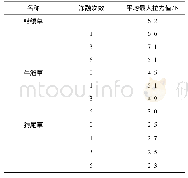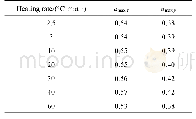《Table 2Predicted damages and service lives at the maximum residual strain point.》
 提示:宽带有限、当前游客访问压缩模式
提示:宽带有限、当前游客访问压缩模式
本系列图表出处文件名:随高清版一同展现
《Damage localization effects of the regeneratively-cooled thrust chamber wall in LOX/methane rocket engines》
where eendis the strain at the end of the considered cycle,ebegin is the strain at the beginning of the considered cycle,and euis the ultimate strain of the considered material.According to Eq.(11),the quasi static damage accumulated in the considered cycle would remain constant as the work cycle proceeds.Although the residual strains in the subsequent cycles have not been presented in Fig.16,the quasi static damage could be estimated based on the residual strains during the initial ten cycles.To identify what roles different damages play on the failure of the inner wall,the damages accumulated in each cycle are summarized in Table 2.The low-cycle fatigue damages are predicted using the fatigue test data of NARloy-Z in Ref.39.As shown in Table 2,the low-cycle fatigue damage in each cycle is almost equivalent,while the quasi static damage accumulated in a considered cycle declines.Nonetheless,the accumulation of the quasi static damage seems to be stabilized after ten cycles.Because the quasi static damage is greater than the low-cycle fatigue damage by one order of magnitude,the total damage is dominated by the quasi static damage.It can be noted that the change pattern of the total damage with work cycles is consistent with that of the quasi static damage.Since the predicted service life is simply a linear extrapolation cycle number from the total damages of the completed cycles,40as a result,the life obtained at the end of a considered cycle rises when the cycle number increases.The life obtained at the end of the first cycle is nearly twice as long as that of the second cycle.However,the predicted lives after ten cycles are likely to tend to be constant.These results demonstrate that the traditional single-cycle life prediction which regards the service life as the reciprocal value of the total damage15is a relatively conservative and safe method for engineering.As discussed above,the failure of the cooling channel in the nearthroat region would occur at the maximum residual strain point.Table 3 presents the predicted damages and service lives at the maximum residual strain points in different cooling channels based on the thermal-structural analysis of ten cycles.The quasi static damage of Channel 3 is apparently greater than those of other channels,while the low-cycle fatigue damage of Channel 3 is much smaller than those of other channels.Ultimately,Channel 3 has a much shorter life than those of other channels,which once again demonstrates that the service life is controlled by the quasi static damage resulting from the thermal–mechanical ratcheting.The maximum discrepancy of the predicted lives between different cooling channels is close to 30%.The data indicates that the damage localization effect is so noticeable that much attention should be paid to it in the design phase of thermal protection systems of thrust chambers.For a reusable thrust chamber taking account of both performance and safety,the life prediction in this paper based on the results of multi-cycle thermal-structural analysis with a multichannel model is expected to capture the damage localization effect and track its evolution.
| 图表编号 | XD0025765400 严禁用于非法目的 |
|---|---|
| 绘制时间 | 2018.08.01 |
| 作者 | Jiawen SONG、Bing SUN |
| 绘制单位 | School of Astronautics, Beihang University、School of Astronautics, Beihang University |
| 更多格式 | 高清、无水印(增值服务) |
查看“Table 2Predicted damages and service lives at the maximum residual strain point.”的人还看了
-

- 表4 冻融作用下拉拔试验拉力峰值Table 4 The mean maximum pulling forces at the root-soil interface of Zoysia japonica, Eleusine indica a
-
![表2 不同入模温度下的回冻效果[20]Table 2 Refreezing times and maximum temperature rises at mould temperature of 5, 10 and 15℃[20]](//bookimg.mtoou.info/tubiao/gif/BCDT201802018_31900.gif)
- 表2 不同入模温度下的回冻效果[20]Table 2 Refreezing times and maximum temperature rises at mould temperature of 5, 10 and 15℃[20]

![表2 不同入模温度下的回冻效果[20]Table 2 Refreezing times and maximum temperature rises at mould temperature of 5, 10 and 15℃[20]](http://bookimg.mtoou.info/tubiao/gif/BCDT201802018_31900.gif)



